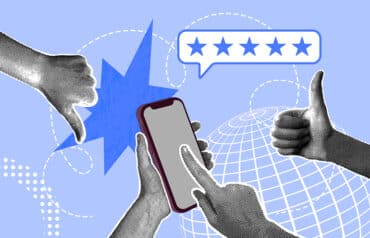Great legal services are required for success. But great client communications strategy is what really increases satisfaction and prompt clients to return.

Table of contents
Margaret Atwood, the author of “The Handmaid’s Tale,” has frequently noted that with all technology, there is a good side, a bad side and a stupid side that you weren’t expecting.
With major advances in technology, like the internet itself, it is easy to think of examples of all three. Of course, since digital communication tools permeate the world and the workplace today, it’s almost unavoidable that lawyers’ business communications with clients are largely done via technology. So it is a useful oversimplification to state that law firms should design an overall client communications strategy of minimizing the bad, enhancing the good and avoiding the stupid. This requires thoughtful planning that must be done expeditiously and reviewed regularly because technology will continue to evolve.
Here are some ideas to consider in your planning at this point.
First, Recognize the Limitations of Email
Technology distances us from one another even as it connects us. The ability to instantly communicate is sometimes beneficial, but often creates its own stresses and clouded expectations. Email is helpful when a digital record is needed. It allows busy people to communicate without having to schedule a discussion. But those benefits may be dwarfed by the challenges presented by email, the volume of email and flood of information it contains, and the security threats posed by emails.
If we only had to read or delete all the emails we receive, the task might be manageable. But many emails contain a question, an assignment or some other content requiring a response.
Email is more remote and distant than phone conversations or in-person meetings. It is good for sterile and complex information or sending a file attachment, but poor for establishing or building trust and relationships. None of us really enjoys dealing with inboxes, so when we communicate with email we may find the recipient begins from a place of haste, inattention, and even negativity. Email is not going to vanish from business communications any time soon. But recognizing and avoiding its limitations will yield benefits.
Scheduling Meetings? There’s an App for That
Now, let’s address one “stupid” use of email. Never send an email trying to schedule a meeting with three or more people. Someone will fail to reply. Someone will respond on another topic. Soon you may have invested a half-hour just trying to schedule a meeting or conference call. This is frustrating for you—and for clients as well. When you are scheduling an appointment with busy people, whether they are lawyers or client representatives, you want to use a scheduling app. Some of these may be built into a practice management system portal, but there are a number of free or modestly priced apps to handle the task. Some options are Doodle, WhenIsGood, NeedToMeet, and Timebridge.
Some scheduling apps integrate with Google, Microsoft Outlook or Office 365 to automatically look for “open” times in the participants’ calendars. I prefer proposing several options of my own and sending those off for responses.
And soon you may be assisted in scheduling by artificially intelligent chatbots (if you aren’t already). You just copy your chatbot on the email discussing the need to schedule a meeting and the chatbot will handle all the back-and-forth via email, checking in with you as needed, until an agreeable appointment time is reached. Several companies now offer this service.
Put a Face to the Voice
Today’s technology allows you to see your kids, loved ones, and friends as you talk with video-calling tools from FaceTime to Skype. It’s pleasing to see them and helps maintain relationships. As lawyers spend a lot of time negotiating and talking on the phone, wouldn’t we be better off having those conversations with clients using videoconferencing tools as part of a client communications strategy? Your business clients already routinely do it with others. If a client who owns a smaller business doesn’t know how to do that, a law firm might create astonishing goodwill by sending a techie over to install and do brief training on a law firm-supplied webcam.
A young woman recently mentioned to me how she had looked forward to an online meeting about a milestone reached on a big project. When everyone logged in, she was the only one using her webcam. That’s not a comfortable situation, and when she made a remark about it, the lawyers who logged in quickly volunteered that they either didn’t have webcams or didn’t know how to use them. It is the 21st century. Being cluelessly out of touch with commonplace tools is not a good way to inspire client confidence.
Embrace the Client Portal
A client portal is an essential for good client service and communication. At a minimum, you want one because your firm needs a secure method for confidential client communication and document sharing. Email isn’t it. Several types of online document repositories and deal rooms have been established.
Law firms with IT staff can build their own client repositories or vet providers that can build tailored solutions. Solo and small firm lawyers can subscribe to online practice management tools that organize their client matters and provide client portals at a very affordable price.
An assistant general counsel on a road trip may appreciate logging into the law firm’s client portal to review documents far more easily than she can log into her own company’s records. An individual client who might have trouble dealing with encrypted email will like being able to easily log into a website with a user name and password. But the law firm portals of today may seem primitive compared to those in the near future. Imagine a practice group that hosts numerous “For client eyes only” resources as a free “value-add” behind the portal login. Or what about legal chatbots operating behind the portal assisting clients in ways besides appointment scheduling.
For consumer clients, imagine a wealth of information not just about their ongoing matter, but covering dozens of frequently asked questions that consumers have about legal issues. One might explain notarization, for example, and note that clients with active matters can have free notarization service through the firm.
A law firm representing individuals might expand that concept with clients paying a modest annual fee for accessing the rich resources of the law firm portal. Portal-based services could range from attorneys responding to a number of routine questions to clients drafting routine documents that would be reviewed by law firm personnel. If a satisfied former client has been visiting the law firm portal regularly, that firm certainly has an inside track if more legal services are needed in the future.
Consider Videos Emerging as Client Services
It’s not uncommon for lawyers to develop white papers for clients, but even using the term “white paper” is dated in some ways. While there are certain topics that must be covered in a lengthy written narrative, many topics could be covered with a quickly created video. The next time you are tempted to type out a 12-paragraph explanation to a coworker, take a few notes, turn on your webcam and record a quick video instead. You may find it takes far less time and is appreciated more. Then go ahead and try a brief, simple video on a topic of interest to a client group. Dozens of law firm videos for clients on the firm website or behind the client portal firewall would be impressive—although you’ll want an administrative mechanism to make certain outdated videos are removed or rerecorded with updates.
Email newsletters to clients are often deleted unread. An email with a subject line of “5 New Free Videos for You on KZ Law Portal” does its job in the subject line.
Top Tip on Client Communications Strategy: What Does the Client Want?
Many times we are forced to use electronic communications to interact with clients. Despite the frustrations of email and other digital communications, they do have the advantage of providing a more accurate record than attempting to recall an oral conversation.
But many people dislike technology or aren’t adept at using certain tools. You should always ask new clients about their communication style and preferences. Some may have strong preferences that they might not mention unless you ask. If an otherwise tech-savvy client confides that he has trouble keeping up with his email, a friendly “Can I text you when important items are uploaded to the portal so you won’t miss them?” might be seen as very helpful. Some clients really may prefer that they receive traditional correspondence via the U.S. mail. Let them know that is an option, but also communicate that you may need to place more telephone calls to them if things start moving quickly.
Be Sticky
Great legal services are still required for success. But increasingly, great client service and communication are what really increase satisfaction and prompt clients to return to the firm for more legal services.
In website design, it’s called being “sticky” when visitors linger longer and return in the future. People appreciate added value. It could be something as simple as emailing your estate planning clients a PDF fillable-form document to prepare and update an inventory of their assets to be kept with their will. Also, client communication is critical, and billable. Great value-added resources behind the portal firewall can provide extra value to clients without dipping into the firm’s important inventory, attorney time, every time that value is delivered.
When representation ceases, the message you want to deliver is “we are waiting for the next opportunity to help you” — not “we have been paid and are done with you.”
Related: “Must-Have Technology for Better Client Service”
Ed. Note: Excerpted from our “Happy Clients, Happy Lawyers: Tips for Better Client Relationships” guide for creating a more efficient and less-stressed law practice. Download your copy below.
Illustration ©iStockPhoto.com
Subscribe to Attorney at Work
Get really good ideas every day: Subscribe to the Daily Dispatch and Weekly Wrap (it’s free). Follow us on Twitter @attnyatwork.
















